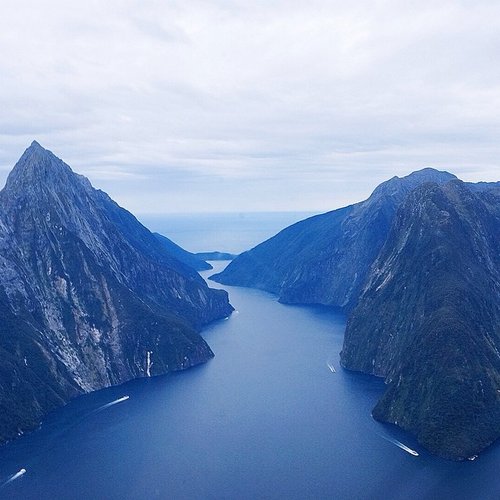New Zealand’s South Island
Yesterday’s journal highlighting New Zealand’s North Island certainly had some amazing sites. Let’s take a peek at what the South Island has to offer. Christchurch will be my last stop before heading to the ice. Can you find it on the map?
 Picture of New Zealand’s North and South Islands. Photo credit: CIA World Factbook
Picture of New Zealand’s North and South Islands. Photo credit: CIA World Factbook
Milford Sound and Fjordland National Park
When I tell people I’ll be travelling through New Zealand to get to Antarctica, several have asked, ‘Will you visit Milford Sound while you’re there?’ This area has been called ‘the eighth wonder of the world’ by some and ‘the most stunning fjord in a park full of stunning fjords’ by others. Since this is my last trip and if I have any free time, Milford Sound will be my first stop. But wish me luck because it will take some time to get there. Milford Sound is located in Fjordland National Park on the South Island’s southwest corner.
Take a look at what I might see if I’m lucky enough to visit Milford Sound.
 Beautiful Milford Sound. Photo credit: Lim Ashley, Flickr
Beautiful Milford Sound. Photo credit: Lim Ashley, Flickr
Whoa! Look at that!
Did you know that a fjord is a long, steep, narrow inlet of sea surrounded by steep cliffs that were formed by glacial activity? New Zealand is famous for them!
Glacier County
In the heart of the South Island’s West Coast and nestled in the foothills of the Southern Alps sits two amazing geological features, the Franz Josef Glacier and the Fox Glacier. Both glaciers offer potential visitors/tourists, like me, a unique experience. It’s not often that you get the chance to encounter a dynamic glacier in a reasonably moderate climate. Not to mention this area boasts some of New Zealand’s most spectacular views. I have heard the West Coast of New Zealand’s South Island is not to be missed.
 Is anyone up for a hike on Franz Josef Glacier? Photo Credit: Wikimedia Commons
Is anyone up for a hike on Franz Josef Glacier? Photo Credit: Wikimedia Commons
Paparoa National Park
Located on the South Island’s West Coast, this park has so much to offer a nature lover, from beautiful coastline beaches to jagged-peaked mountain ranges and everything in between. In fact, it is very geologically diverse. Let’s take a peek at two of the unique features in Paparoa National Park.
When a significant amount of water moves through and erodes limestone, interesting geological features can form. Caves and sinkholes are examples of these features. This region is known as a karst.
Seabirds, sandy beaches, high cliffs and crashing waves are all typical features of this beautiful coastal region. But pancake rocks are the best-known and most unique feature in this area. Pancake rocks are uniformed plates of eroded limestone, an ideal place to form surge pools and blowholes.
 The Pancake Rocks at Paparoa National Park. Photo credit: Christian Michael
The Pancake Rocks at Paparoa National Park. Photo credit: Christian Michael
Dunedin, New Zealand
Although the South Island’s West Coast is stunningly beautiful, its East Coast also has a great deal to offer. I’m hoping to visit Dunedin - South Island’s second largest city, after Christchurch. Two things have piqued my interest, a grand cathedral and a tiny penguin.
I will see Emperor and Adelie penguins in Antarctica. Both species, however, would tower over the Little Blue penguins I hope to see near Dunedin. These tiny flightless birds stand only about 10 inches tall. And as you might have guessed by their name, Little Blue penguins are covered with slate-blue feathers on both their head and back. Like the Emperor and Adelie penguins, the feathers on their belly are bright white.
 True to its name… the Little Blue penguin. Check out those feathers! Photo Credit: Wikimedia Commons
True to its name… the Little Blue penguin. Check out those feathers! Photo Credit: Wikimedia Commons
In the heart of Dunedin sits the magnificent St. Paul’s Cathedral, not to be confused with the famous Cathedral dedicated to St. Paul in London, England. Two centuries younger than its U.K. counterpart, the Cathedral of Dunedin, built in 1919, is a beautiful landmark. Just look at the details in the architecture! The Cathedral shares the same grounds as the city’s town hall and town square, making this city-center a busy hub rich with different peoples and cultures interacting with one another!
 St. Paul’s Cathedral. Photo by Mark McGuire, Flickr
St. Paul’s Cathedral. Photo by Mark McGuire, Flickr
Escape Quest, Queenstown
And now for something silly and fun in Queenstown, New Zealand, in the southwest part of the South Island!
 The Escape Quest Logo with a rather dashing little Kiwi! Photo credit: Escape Quest NZ
The Escape Quest Logo with a rather dashing little Kiwi! Photo credit: Escape Quest NZ
Read this: ‘In the rugged isolated beauty of Skippers Canyon, a miner and his wife have disappeared after finding the largest gold nugget ever found. Their children have received a ransom note: their parents’ lives in exchange for the gold nugget.’
Are you intrigued yet? Would you like to play this ‘escape the room game?’
Yes, it sounds a little silly and fun, but if I were to accept this challenge, the Weddell seal team and I would be asked to ‘step into the miner’s cottage, find the nugget and solve the crime.’ But we’d better be quick, we only have 60 minutes.
This sounds like a great way for a visitor to learn about New Zealand history while having some crime fighting fun!
 Escape Quest’s lobby, with the challenge being just beyond that white door! Photo credit: Escape Quest NZ
Escape Quest’s lobby, with the challenge being just beyond that white door! Photo credit: Escape Quest NZ

Comments